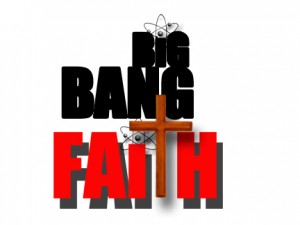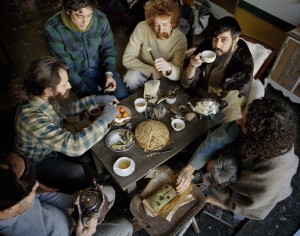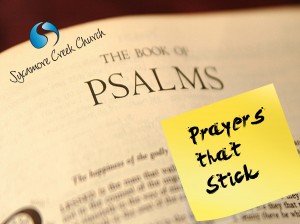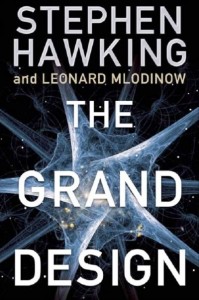Big Bang Faith – The Who Banged It Theory
Sycamore Creek Church
April 15, 2012
Tom Arthur
Genesis 1:1
Peace Friends!
Faith is the great cop-out, the great excuse to evade the need to think and evaluate evidence. Faith is belief in spite of, even perhaps because of, the lack of evidence.
~Richard Dawkins
Religion and science are incompatible, incongruent, and irreconcilable.
~Christopher Hitchens
So say the new atheists. Science and faith just don’t go together. Science is about truth. Faith is about something else. But is this really true? Are science and faith so incongruent after all? Or do we need to divorce the two and get on with our lives?
I’d like to suggest to you over the next four weeks that science and faith are not in contradiction to one another. Sometimes they overlap more than other times, but all in all, science and faith can not only coexist but thrive together.
Perhaps a quick analogy is in order. Science asks the question How? Science tells us that a kettle boils because gas combusts with oxygen and releases energy in the form of heat. But is this all that can be said about what’s going on here? What about the Why? A kettle boils so friends can sit down for a cup of tea. Or in the case of one group of friends, a men’s tea party! Can science answer the question of why a men’s tea party?
Literal or Something Else?
Ok, let’s back up a bit. Let’s go back to the very beginnings of the clash between science and faith. Who do we go back to here? Galileo. Right? The big controversy of the day was between Galileo’s teaching that the earth moved around the sun and the church’s teaching that the earth was the center and everything else moved around it. Who was right? Galileo. OK, Galileo, the church was wrong. We’re sorry. Please forgive us.
Actually, in apologizing to Galileo we’re making an apology within the Christian community because Galileo was a Catholic and remained one (on house arrest). He even saw that what he was doing was part of fulfilling God’s purposes for his life. So when we, the church, apologize to Galileo, let’s remember that we’re apologizing to one of our own. Just in case he missed it the first time: Galileo, we’re sorry. We were wrong. You were right. Please forgive us.
Now let’s look at some of the scriptures that the church used to argue against Galileo:
The world is firmly established; it cannot be shaken.
Psalm 93:1 NLT
The sun rises at one end of the heavens and follows its course to the other end.|
Psalm 19:6 NLT
Does any Christian of any stripe or flavor today believe that these verses (and others like them) require us to believe that the Earth doesn’t move and that everything else (sun, stars, galaxies, etc.) revolves around the Earth? No. I have never met even the most ardent fundamentalist who wants to hold that because these two verses are in the Bible that Christians must believe in an Earth-centered universe. We have noticed since the time of Galileo that these verses are poetic in nature. They are in the Psalms, a book of poetry!
So let’s look at another more contentious (by today’s standards) verse:
In the beginning God created the heavens and the earth.
Genesis 1:1 NLT
If we continue reading this we all know that the way the story goes, God created everything in six days and rested on the seventh. The question before us then is this: is this story at the beginning of Genesis more like the poetry of the Psalms or is it more like the history of some other books of the Bible?
You may think that this is a question that has only arisen in modern times by modern Christians wrestling with science. You would be wrong. This is a live question throughout almost all of Christian history. Just to give you a taste of Christians who wrestled with this in much earlier times, here are two:
Now what man of intelligence will believe that the first, the second and the third day, and the evening and morning existed without the sun, moon, and stars?
Origin (2nd-3rd Century)
We do not read in the Gospel that the Lord said that I send to you the Paraclete [Holy Spirit] who will teach you about the course of the sun and the moon, for he wanted to make Christians and not mathematicians.
Augustine (4th-5th Century)
Did you catch that? As early as the second century, Christians were thinking that Genesis chapter one is perhaps not to be taken literally. So if not literally, then how are we to take Genesis’ creation story? Here’s my educated guess at this point in my understanding of what is going on in Genesis’ creation story.
Genesis chapter one is a poetic account of God creating his very own temple. The creation of this temple runs parallel to the creation of the tabernacle as it is told later in the Torah, the first five books of the Bible. When someone creates a temple, what is the last thing that gets put in the temple? The idol. Right? Interestingly enough, the word that is translated “idol” in other places in the Old Testament is translated “image” in Genesis. Now who or what bears God’s image in creation? Human beings are made in the image of God. Creation is God’s temple, and we are God’s images, God’s idols, if you will. Why is this important? Because there is a political undertone, a subversive message in a story that says that all humanity (men and women) are made in God’s image. Remember who was considered God’s image in ancient times? The kings. So if a story about creation suggests that the king isn’t the only one made in God’s image, whose power is that story undermining? The king’s power! So Genesis is a poetic story of God creating God’s temple and creating all of us as God’s image so that we wouldn’t forget that it’s not just the kings who matter to God. Genesis’ creation story is less a science book and more a political manifesto.
The Big Bang Theory
Christians have often considered there to be two books by which we learn about God. The first book is of course the Bible. We’ve been looking at that book so far. But there’s another book: the book of creation. Science is the study of this book. Science does its best to answer the question of How? when it comes to describing the book of creation. It should be obvious but let me say it anyway, all truth is God’s truth no matter where you find it. When you find truth in science, it is God’s truth. When you find truth in people who aren’t Christians, it is God’s truth. When you find truth in the Bible, it is God’s truth. All truth is God’s truth. Science is an exploration of the truth about creation.
Science tells the story of the beginning of creation in a different way than the book of Genesis tells it. The title of Science’s story is often called the big bang theory. In a nutshell, science has shown mathematically how the universe is expanding. If you take those trajectories and run them backwards, you end up with what science calls a singularity: the moment when all matter is condensed into a single point. It all had a beginning.
Did you know that the first person to prove this idea mathematically was a Belgian Catholic priest named Georges Lemaître? Yes, it was a Christian who first proved the Big Bang! Lemaître even went head to head with Einstein on this. Einstein said, “Your math is right, but your physics are abhorrent.” In the end Lemaître won that argument.
Not only did Lemaître win that argument with Einstein, but he also took his information to Pope Pius XI. This was so compelling to Pope Pius that he proclaimed the big bang theory as compatible with Christian faith. Pope Pius was more confident than Lemaître about this. Lemaître was concerned that should his math or physics be proven wrong, then the faith would be disgraced by the Pope’s public proclamation. Well, in the end neither Lemaître nor the Pope proved to be wrong and the vast majority of physicists believe that the big bang theory is a correct way to describe the beginnings of the universe.
One very interesting piece of science that goes along with the big bang theory is what some physicists call the anthropic principle. “Anthropic” means human-centered. Here’s how it works: There are six fundamental constants of matter that allow human life to exist because they are exceptionally fine-tuned.
Let’s look at one of those constants called Lambda or sometimes “dark matter.” Lambda is the parameter which controls the long-range acceleration of the expansion of the universe in relativity. Did you catch that? Neither did I. But basically it has to do with how fast the universe expands from that moment of singularity in the big bang. The value of lambda is a factor of 10-120. That’s a one with a hundred and twenty zeros following it. If lambda were a shade off one way or another, human life could not exist.
So how improbable is it that lambda and these other five universal constants are so finely tuned? Just to have one of them so finely tuned would be would be equal to “getting the mix of flour and sugar right to within one grain of sugar in a cake ten times the mass of the sun” (Tony Hewish as quoted by Polkinghorne). Or consider making a hole-in-one on the golf course. The current record is 448 yards. The fine-tuning of one of these constants would be like hitting a hole in one teeing off from Pluto times thirteen! Put all these together, and I’ve heard it described this way: It’s like a tornado blowing through a junk yard and creating a fully functioning 747. The probability of these things happening as they have is beyond minute. The universe is exceptionally fine-tuned to support human life. Did it just happen that way? Or were the dice loaded?
A Strange World
The world is stranger than we all thought. In some ways it’s stranger than we could have ever imagined. Quantum theory has shed a strange light on what we know about the way the universe works. Classical physics, the brain-child of Isaac Newton (who was a Christian), attempted to describe mathematically the way that objects move, but as we began to be able to see ever smaller and smaller objects (protons, electrons, quarks, and now bosons, nick-named “the God particle”), physicists noticed that they didn’t move the way that classical physics said they should. Things are weird at the subatomic level. Matter and energy act like both waves and particles. Werner Heisenberg developed his famous Heisenberg uncertainty principle: you can know where something is going or where it is but not both at the same time! In fact if you shoot an electron at a wall with two openings on it and record where it goes, you’ll notice something strange: it appears to have gone through both openings! String theorists think that the electron going from point A to point B takes every possible path to get there. This means that every possibility is possible. And this has led some physicists, like Stephen Hawking, to believe in a multiverse: multiple universes where every possibility plays out at least once.
Faith Seeking Understanding
The world is definitely even stranger than you can imagine. And yet when I read about these developments, I am inclined to simply be more and more in awe of God. I don’t see the progression of scientific knowledge as antithetical to my faith. I see it as informing my faith in a very interesting and dynamic conversation. And I’m not the only one. One scientist I have learned a lot from is John Polkinghorne. Polkinghorne was professor of Mathematical physics at the University of Cambridge from 1968 to 1979 before he left his endowed chair to become a priest. Now he spends his time lecturing and writing about the intersection of faith and science. I listened to his introductory textbook , A Short Introduction to Quantum Theory, while preparing for this series. It’s not a book about faith or God. In fact God never comes up in the book. It is a basic text book for upper-level physics classes, or perhaps physics for non-physicists.
Polkinghorne is a theoretical physicist scientist through and through, and yet in his book he told the story of researchers finding the positron. The positron is a subatomic particle the size of an electron (much smaller than a proton) but positively charged. No one even looked for this particle until a new radical theory suggested it should be there. So researchers went about looking for it and found it. They even went back to old experiments and noticed that it could be seen there too. Polkinghorne comments that “researchers tend not to notice things they aren’t looking for.”
Several hundreds of years earlier, Augustine said basically the same thing: “Therefore do not seek to understand in order to believe, but believe that thou mayest understand.” We tend to think that you have to understand before you can believe, but as the search for the positron shows, sometimes you have to believe before you can see or understand it. Anselm, a Christian scholar writing in the eleventh century wrote a book called, Faith Seeking Understanding. In it he suggests that Christians should seek understanding about God and our world from a foundation of faith. There is a kind of humility in both Augustine and Anselm. It is a humility that recognizes that we don’t know everything. Our knowledge is and always will be finite.
Christians can learn from science and science can learn from Christians. Science seeks to answer the question of How? And faith seeks to answer the question of Why? Why is there something rather than nothing? And that brings us back full circle to that men’s tea party. I’m not so interested in how this exists, but why does it exist?
For Further Exploration
www.testoffaith.com
John Polkinghorne – Questions of Truth
John Lennox – Seven Days that Define the World







Recent Comments